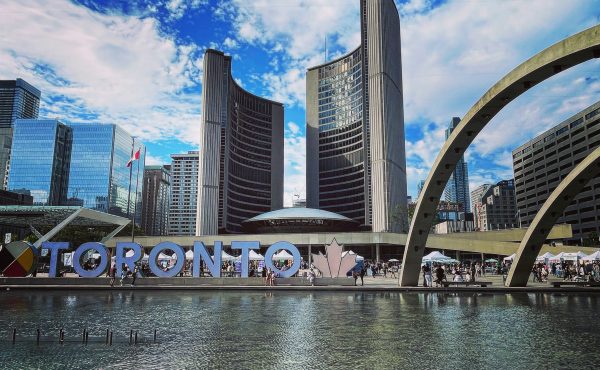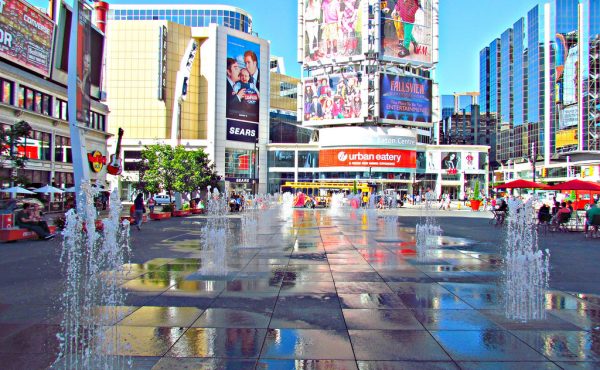A typical intersection in Los Angeles.
If Councillor Norm Kelly gets his way, every single billboard in this city will be allowed to turn into an electronic sign. Why? Because “Guess what, we live in an electronic age!” Seriously. That’s his argument.
Under the pretext of “modernization,” Los Angeles City Council ignorantly made a similar decision in 2006, as chronicled in this nightmarish L.A. Weekly feature from just over a year ago. One L.A. councilman told the paper, “obviously many of us regret it.” Another said, “When we discussed digital, I don’t think anyone had a clear idea of what it was about. It was new to me…I don’t know if any of us saw how bright they would be. It’s a whole new world.”
But you don’t have to look to Los Angeles. You can always just read this letter from a poor sucker who has the misfortune to live within a mile of the illegal CBS video screen on top of the Amsterdam Brewery at the foot of Bathurst.
And allowing third-party signs to display “electronic static copy” isn’t even the only one of Kelly’s motions that would transform the new Bylaw into an ironic mockery of its original intent.
As the chair of the Planning and Growth Management Committee, Kelly was the first to speak to the item when it hit Council on Tuesday. (The debate will continue on Monday.) He was also the first to move amendments to what staff were recommending.
What usually happens when a report comes to a full meeting of City Council after having been at committee is that that committee’s chair reaffirms his or her committee’s recommendations. That did not happen here. One, the committee had sent the report to Council without its own recommendations regarding a specific tax amount, instead asking staff to bring their recommendations directly to Council; two, Kelly came armed with a set of motions tweaking both the tax rate and the substance of the new billboard rules.
Prefacing his comments with a confused paraphrase of the parable of King Solomon and the baby, Kelly stressed that he was aiming to achieve a sort of rigid compromise by cutting the tax amount down the middle. Staff are proposing the Billboard Tax at $10.4 million, 1.8 million of which will pay for the new Sign Unit that will administer the Bylaw. Kelly would prefer a greatly reduced tax, which he calculated by taking the difference between those two numbers, cutting it in half and then adding back in the money for the sign unit; i.e., (10.4 — 1.8) à· 2 + 1.8. That’d bring in $6.1 million, or 59% of what staff are recommending.
He also made several motions that would effectively hack the baby to bits under the pretense of equitably bisecting it. A sign bylaw is a very delicate thing; you can’t just adjust details here and there. Each provision has to work in harmony with the others in order to sustain a stable framework that regulates the potential opportunities for both new and existing signs. Kelly is proposing seemingly arbitrary changes based, apparently, on his own gut feelings.
For example, staff recommend that new billboards be prohibited within 30 metres of an intersection. Kelly, for whatever reason, thinks this should be 6 metres instead. Such a change would allow an immediate doubling of the current number of billboards in Toronto, according to the Chief Building Official.
Kelly seems to have an unnervingly warped conception of the Solomonic myth, which of course was not actually about the need for aggressive compromise but rather the precise opposite. (I would hate for him to be a judge in a Family Law court.) It was about using an unpalatable, hypothetical solution to call the bluff of the party that’s lying to you. As such, it was quite enjoyable watching Councillor Joe Mihevc — who actually has a PhD in theology and social ethics — ask questions of Kelly, who did his damndest to recall what the rationale for each of his proposals actually was. (I certainly wasn’t the only person in the Chambers who considered it a possibility that at least some of the motions were handed to him already written.)
It’s a shame that Mayor Miller has thus far taken a largely indifferent stance on both the tax and the bylaw, offering support that at best has been quiet and lukewarm. The artists and others advocating for the tax are the same people who, two years ago, loudly rallied around the Land Transfer and Vehicle Registration Taxes, forming a popular movement that help him push those through Council. (Yes, the LTT was watered down before it was adopted, but — in proportional terms — not as much as the Billboard Tax is set to be.) Community arts, cultural investment, priority neighbourhoods, and urban beautification are topics the mayor likes to touch on whenever he gets a chance. And here’s an opportunity to leave a real legacy in all of those areas — a “win-win-win-win” situation, as he likes to say.
When the mayor delivers a fiery, passionate speech at the conclusion of a Council debate, he easily wins his side an extra ten votes they likely would not otherwise have had. The mayor is therefore better positioned than anyone else to ensure that this two-year process to develop a new Sign Bylaw and Tax goes out with a great big bang, rather than with Norm Kelly’s muddled whimper.
Jonathan Goldsbie is a campaigner with the Toronto Public Space Committee.




23 comments
I know this will not be well received, but I believe that earmarking the billboard tax for arts funding, while it may have helped the polling numbers, undermines the basic argument — the billboards are a blight on the civic landscape and if the industry has its way, we will be begging them just to go back to their currently illegal practices.
As for Norm Kelly’s motion (the term “Councillor” dishonours his colleagues), they are blatant industry pandering in the worst style of the old Lastman “business friendly” Council. Why David Miller puts up with Kelly as a committee chair and member of the executive.
The entire set of amendments should be voted down, but I suspect we will see some of them passed and that may be the real strategy. Ask for a ridiculous set of giveaways, and be happy to get half of what you asked for. Sort of like King Solomon’s baby act.
“Compromise” is not a word that should be part of this debate. The industry has shown its true colours, and they need to be stopped dead in their tracks.
With respect to an illegal video billboard — why doesn’t the city simply cut off their power? If the billboard owner wants to complain, so sue us. The city needs to be much more proactive in this sort of problem including actively disabling/masking illegal signs, or demolishing them at the owner’s expense. See you guys in court.
In the previous comment, it should read:
“Why does David Miller put up with …”
Sorry about that.
And, yes, I know that entering into a private building (the brewery) to switch off a billboard would be difficult, unlike the sort of guerilla tactics the city could practice elsewhere, but it’s my intent that should be clear. A property owner who hosts an illegal sign should be the target of significant penalties that would make them think twice about renting out their space.
I am all for cutting off the power to the big flash but I am completely against the tax and adding another mini bureaucracy to administer it to the tune of $1.8 Million a year. We do not need more self inflated egos calling themselves inspectors looking for ways to raise money like the guy who harassed seniors walking in a Park a few months ago. All we need do is enforce existing bylaws with more teeth with existing staff. The tax does nothing to improve public space it just taxes the damage. I’m sure Howard Moscoe would love another division to Lord over but we have too many already.
The advertizers complain that $10 million tax will put them out of business. Good ridance, I say. Absolutely no electronic signs.
I give no credence to the arguments of the ad companies. If they find billboards too expensive, I’m sure they’ll find another medium to satisfy their clients’ needs. I don’t know their industry that well, but I know this is nowhere near stopping them.
Hi Steve – when has something that has been taxed been seen as something ‘good’ after? It is not like a section 37 or something – which is the status quo.
Also what have you done lately to stop Kelly’s motion? Seems like the arts people have been pulling some serious weight lately on the enforcement, fines and strong bylaw side of things. I don’t think there is any public interest group that is more passionate about how the city looks than artists – this alone undermines your whole premise.
Anyway – let’s focus on the motion.
Nothing should ever look like Dundas Square…
Mayor Miller has not taken a largely indifferent stance to the tax and the by-law; as i told EYE Weekly, the Mayor is one of the key reasons this legislation is happening in the first place.
Is there anything that would keep these from being used as video boards? That is my main question. If we can’t even rely on them to fill out permits, let alone properly – how can we rely on them to not use this for full motion video nonstop?
If the arts people cared about how the city looks, they wouldn’t support electronic signs. They’re only looking out for their interests, getting a piece of the pie.
Angus, which “arts people” are advocating for electronic signs? Devon, who is leading the “arts people” in this campaign just rejected this idea. I think you need to get your facts straight.
Billboards are sexy. They entertain, enlighten and inform. They add consumerism and colour to cities. In Mumbai, Delhi and Manila, Billboards exist with no seeming enforcement or By-Laws. Huge A-Frame structures sit atop slum buildings with no setback or size requirements. It feels like capitalism run amok, which is a rush to experience.
I hope Toronto allows static digital everywhere. Maybe it will blind the woah-is-me hypocritical artists wearing LuLu Lemon. The average consumer will be all-too-happy to view them and let the branding influence their lives.
How would electronic signs help Toronto become a greener city? This doesn’t seem like a good idea at all. I hope one person’s ill thought out ideas aren’t able to wipe out a carefully thought out and researched proposal.
Everyone is talking about Zero Carbon footprint. How about zero ugly footprint?
This billboard tax with money going toward arts would help beautify our city by negating the effects of unsightly billboards.
Why shouldn’t the full amount that was originally proposed go to arts? Artists create all the good things we appreciate in life; music, movies, paintings, clothes, jewelry, buildings, books, etc.
Let me quote the Mayor of Barcelona:
“…the need to take care of cultural development emerges as a necessary condition for quality of life…and so to construct culture is to construct the city.”
Obviously there are different opinions but most people agree that the proliferation of billboards undermines the public spaces we enjoy. Therefore, we need to ensure that Council knows we support this motion without the amendments. I suggest everyone contact their Councillor (regardless of whether you have already) to confirm the public support for this bill without amendments.
I’m sure the folks at flap.org will also have a few choice words to say about Kelly’s bird-brained scheme.
Has anyone did a study on how electronic billboards mess up driver’s night vision? The ones I’ve encountered at John and Richmond and on the Gardiner are like disctracting, blinding papparazzi flashes… and I’m just a passenger. I hear this complaint from everyone I ride with.
“I am completely against the tax and adding another mini bureaucracy to administer it to the tune of $1.8 Million a year.”
If a by-law is worth enacting, it’s worth enforcing. The $1.8 Million that bothers you really is “mini”, after all, in the overall budgetary context, and would be funded from the industry being regulated. Should be go for a pointless self-regulatory scheme? Or the present system that relies on concerned citizens’ tireless efforts to report illegal signs? Come on.
Not flashing billboards, but check out the billboards as you approach Kelowna, starting around 1:12 in this video: http://www.youtube.com/watch?v=0_7JHvCTPYo
I looked at the good Councillor’s biography on the City site and see that he is well practiced with not being exactly exact! He says:
“Councillor Norm Kelly is a trained Historian. He studied Canadian political history at the University of Western Ontario (undergraduate) and Carleton and Queen’s universities (post-graduate).
Among his most important accomplishments was his two year research for the best-selling books in the field of Canadian History: The National Dream and The Last Spike.
The National Dream won Canada’s most prestigious literary prize, The Governor General’s Award, and was transferred to television by the CBC in a very popular, award-winning documentary series of the same name.
In researching these two volumes, Mr. Kelly was the first historian to detail the contribution of Chinese workers toward the construction of the Canadian Pacific Railway (the CPR) in the province of British Columbia. The importance of Chinese labour to the building of the railroad that functioned as Canada’s economic and political spine for the first 100 years of Confederation was recently recognized by the erection of a statue in their honour in Toronto by the Chinese community of that city.”
Of course Mr Kelly probably DID research the volumes but the author was Pierre Burton.
Tristou > It is actually the Native Reserve in that video that is to blame. I was there this summer and asked about all the signs and basically there is no local authority over the land on this stretch so the Band has plunked as many signs as possible there to generate revenue which apparently is a very large amount of money. When entering town from the other side it is a big difference. Slightly off topic I found Kelowna to be a very car centric ugly place with house after house crammed on every inch of hill possible. Not the town I remember as a kid. Very disappointing.
Rockband2010: I can get a rush out of billboards, too. And I think it’d take an urbanistically tin-eared zealot to request that Times Square be de-signed, or that Boston remove its Citgo. But all-out demonstrations of “capitalism run amok” really belong in places and situations where, well, capitalism runs amok. Just because Yonge-Dundas Square “works” (which is debatable, though not necessarily for the reasons cited by anti-billboarders) doesn’t mean you have to transcribe its formula any which where. Sort of like porn is “a rush to experience”, too, but it doesn’t mean you have to turn your own family into The Aristocrats.
…just saw one of these billboards on the Met in St-Léonard. It wasn’t at night, so I didn’t get the full effect, but I must say it didn’t bother me that much. Of course, it was by the side of an ugly raised freeway surrounded by shopping malls and used car lots and cheap (and a few sleazy) hotels, so it fits in with the décor.
I must say I wasn’t overjoyed by Young and Dundas, although there were a lot of people about. Because it’s so new, it just seems so, well, copycat actually.
Like we don’t have enough light pollution already.
As for billboards being erected along major highways, they should be viewed in the same light (pun intended) as mobile phones; a major distraction to motorists who for the most part are already distracted enough (yes, I speak as a rather embittered cyclist who has to deal with distracted motorists on my daily commute).
The “traditional” billboards are already nothing more than a blight on the landscape, adding ugliness to the scenery, so one can only imagine what a nightmarish circus of lights it will become, especially in residential areas, if this bill is passed.